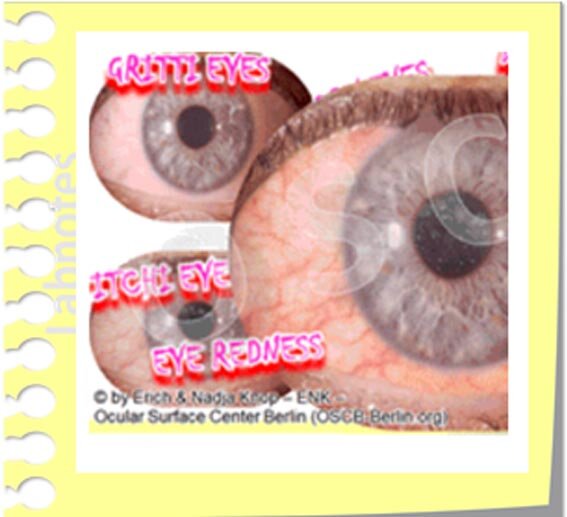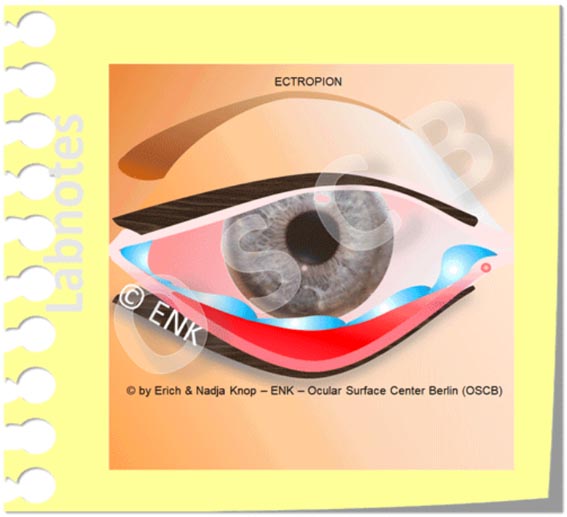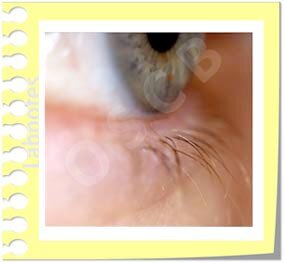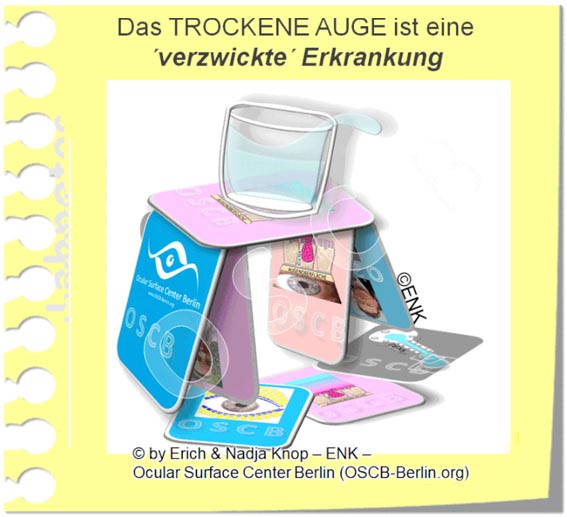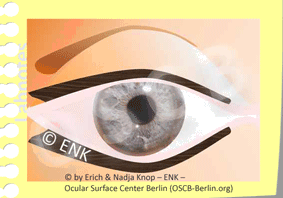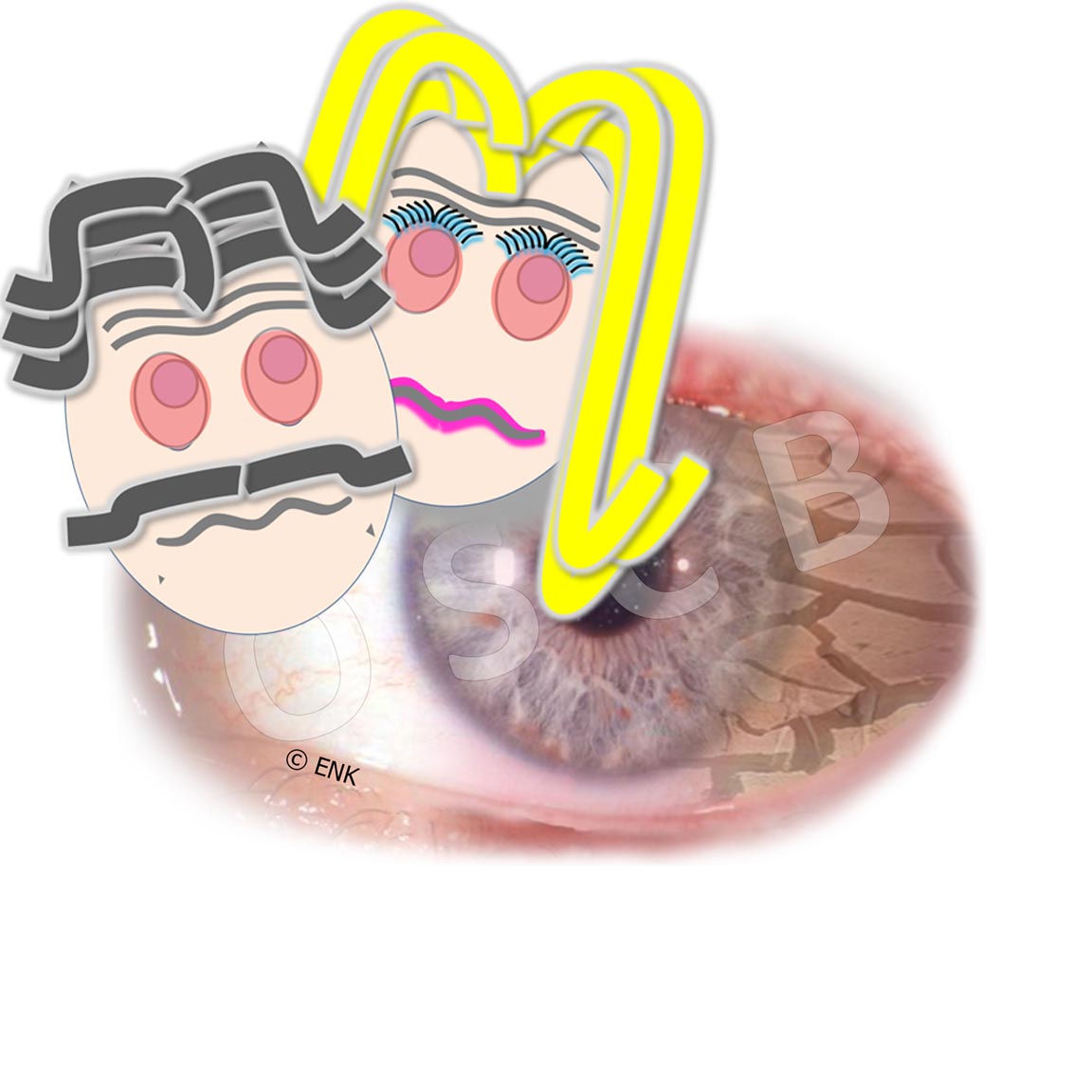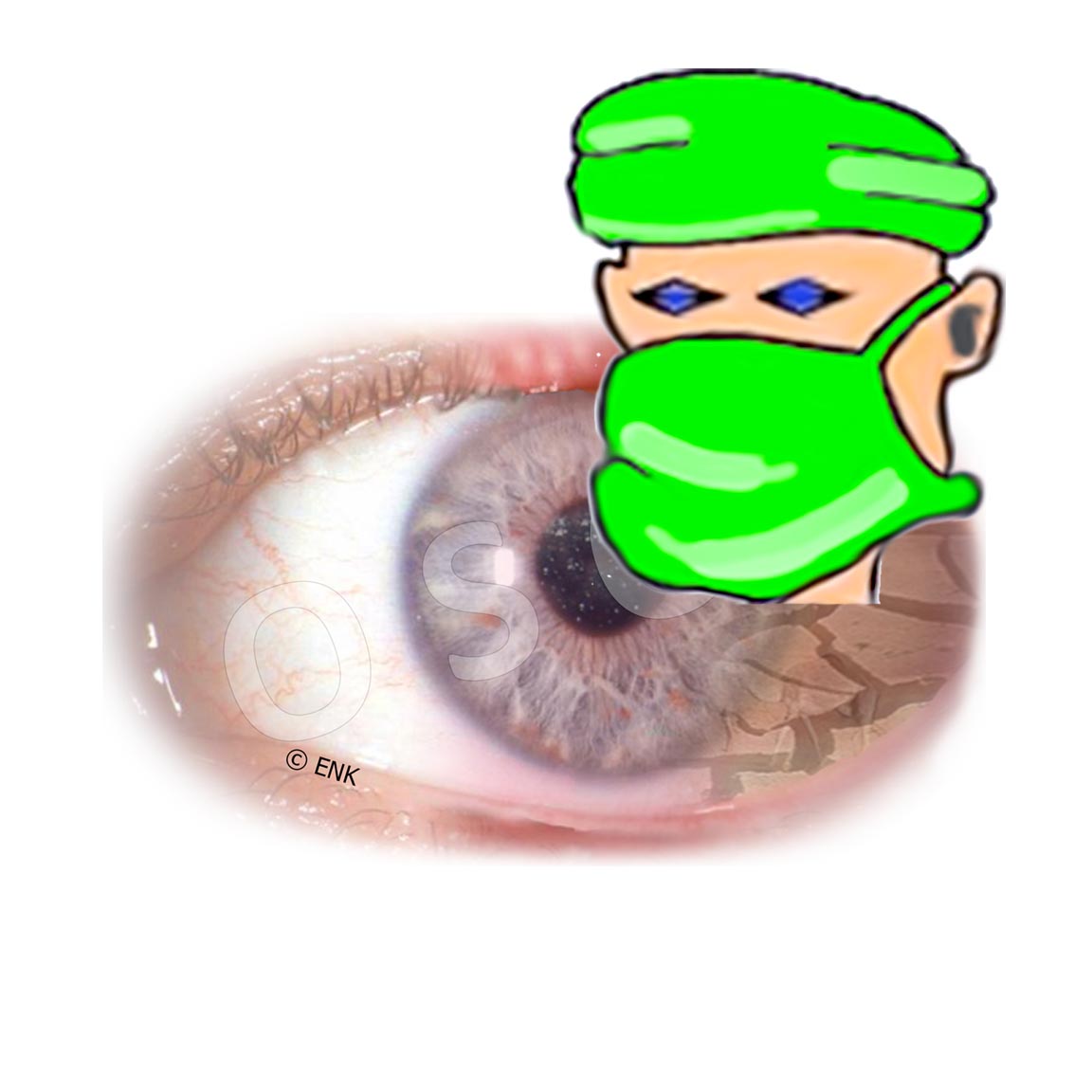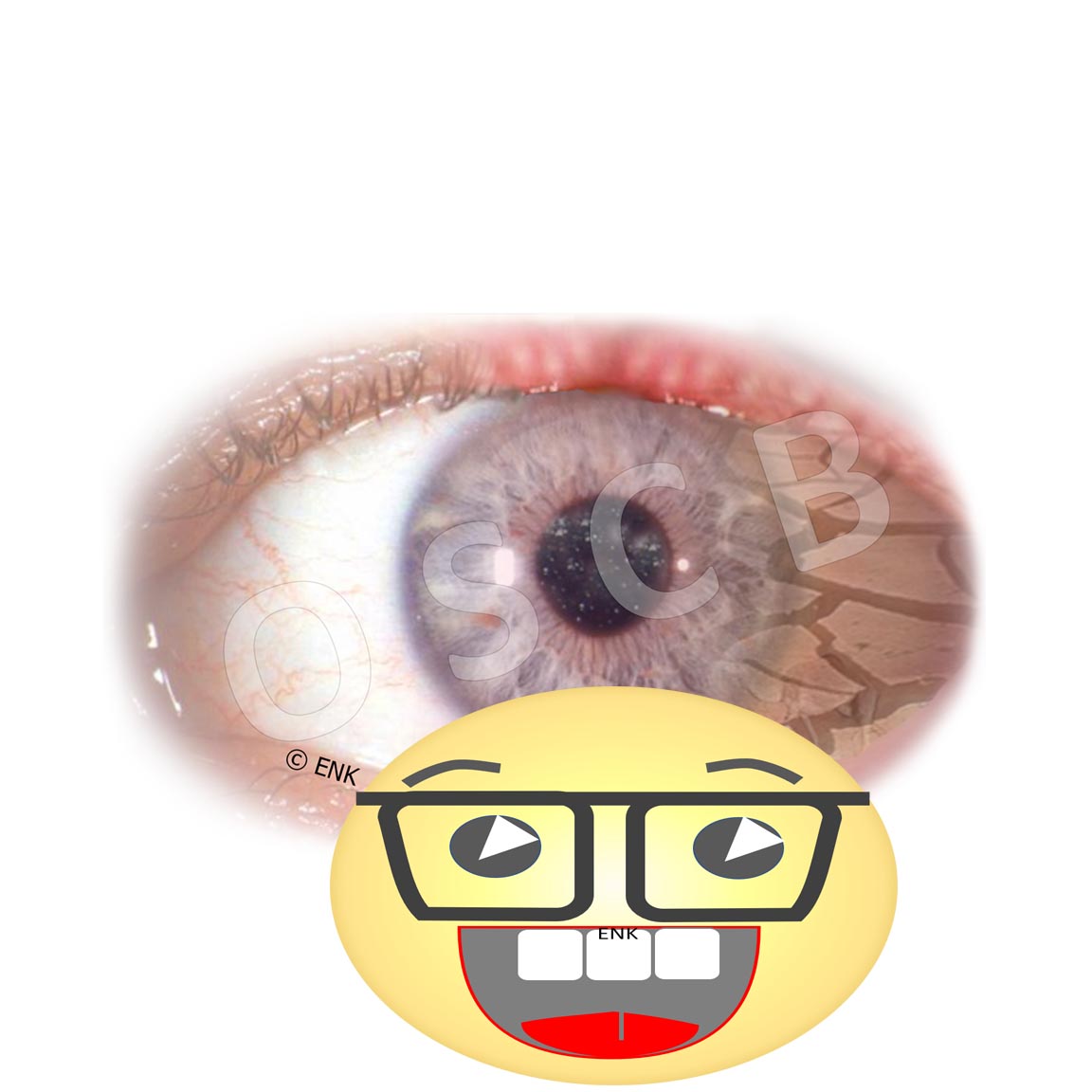=> BACK to PAGE selection for FACTS
Dry Eye, Wet Eye & Eyelids
Links to the CHAPTERS: [ HOME-Page ] [ FACTS & INFORMATION ] [ RECOGNIZE & TREAT ]
On this page you will find the following TOPICS for selection by clicking on an image
.
Irritated eyes - dry eyes - watery wet eyes - eye rubbing - foreign body sensation - burning eyes - red eyes - tired eyes - glued eyelids - blurred vision - unstable vision ... and much more ....
All of these apparently very different, uncharacteristic symptoms can be signs of eye irritation due to damage at the surface of the eye.
This bundle of various dry eye complaints explains its named as “ Sicca syndrome ”
Typically, it is caused by a lack of the tear film on the eye. It can then no longer keep the sensitive tissue sufficiently moist, intact, and healthy. The typical result is a local or general tissue damage, mainly by drying, together with irritation - hence the term "DRY EYE".
Also a wet eye, however, with increased watery lacrimation can be based on or go along with a lack of normal, sufficient and even wetting and thus with a lack of normal tissue protection.
The so-called "DRY EYE" does not always have to be dry
In contrast to its designation as "dry", the irritation of the eye can also lead to episodes of increased lacrimation and thus to a 'wet eye´. This occurs especially at the beginning of this disorder and often in elderly people ... this counter-intuitive observation often seems difficult to understand for patients.
Doctor, my eyes are WET ... how can that be a 'DRY EYE'?
An increased tear flow may be due to a (still) intact defense reflex of the eye.
In the event of irritation of many kinds, e.g. airstream, ventilators, dusty air, or foreign bodies, etc., the defensive reflex ensures that the tears flow strongly to 'flush away' the source of irritation.
If the damage to the surface of the eye has progressed, the nerves will also be damaged.
Then, unfortunately, this protective reflex also stops and the excessive tearing of the eyes disappears ... which is not a good sign in the end.
Other reasons for a “Wet Eye“
A “Wet Eye“ can, however, also have other reasons than increased production of tears. An impairment of tear discharge of ´used tears´ from the eye into the nose may also result in wet eyes. It can occur e.g. due to an altered eyelid shape and function or due to a blockade of the outflow system.
Wet Eye with Blockade of tear outflow and infection - See an Eye Doctor !
Occasionally a blockade of the tear ducts, that drain the tears from the eye into the nose, may be responsible for watery eyes. This goes typically along with bacterial infection and pain and needs timely effective therapie.
=> Therefore, every ´wet´ eye should be seen and diagnosed by an ophthalmologist !
Blurred vision can also occur in a wet eye
The moisture of the tear fluid is necessary to keep the ocular surface healthy - but it is not sufficient to produce perfect vision.
When the thin tear film is inhomogeneous the visual acuity is reduced and typically unstable or fluctuating. This occurs when tears are
too low ... as we can see by a lack of tears in Dry Eye Disease but also
too high, as occurs by an overflow of tears in patients with episodes of excessive tearing in Dry Eyes and in emotional tearing (crying).
So, the volume of tears alone is not sufficient but a thin and homogeneous tear film is necessary.
Blurred vision can thus occur in dry and in wet eyes !
Healthy eyelids are very important for a healthy eye
The eyelids have several important functions for maintaining health at the surface of the eye.
most obvious is probably that the eyelids can close and protect the eyes
the eyelid blink spreads the tears into the tear film, similar to a wind-screen wiper.
the tear film provides the moistening and a sharp vision
the oil glands in the eyelids release oil at the blink so that the aqueous tears do not evaporate so quickly
the eyelid blink also maintains the discharge of ´used tears´ from the eye into the nose.
Changes in the eyelids can lead to a wet eye with excessive tearing
Protruding lower eyelid with curl of the lid edge outwards (ectropion)
Eyes with disturbed eyelid position or with a disturbed function of the eyelids can no longer build up a normal tear film or can no longer hold it on the surface of the eye.
Therefore, a disturbed eyelid position can occasionally be the reason for wet eyes with overflowing of tears over the edge of the eyelid and cheeks - medically known as epiphora.
In addition, the tears can often no longer be pumped normally into the nose due to the change in the eyelid, so that the tears overflow over the edge of the eyelid.
Although the eye is moist, the tears cannot form a stable tear film. This leads to a "dry eye" type of of ocular tissue irritation.
Due to the subsequent irritation of the nerve fibers, even more tears are produced (irritant stress secretion) - However, these tears consist mainly of pure water and therefore cannot form a stable tear film and cannot adequately lubricate the tissue.
Causes of eyelid changes
Rolling the edge of the lid inwards (entropion) with rubbing of the eyelashes on the eye
A disturbed eyelid position can result from
Relaxation of the connective tissue or also
due to scar tissue, e.g.
due to an accident or
Here, urgent medical advice should be sought!
Consequences of eyelid changes
Eyelid disorders can lead to
Protruding lower eyelid with outward curling of the lid margin (ectropion) or
Inward curling of the edge of the eyelid (entropion), often with rubbing of the eyelashes on the eyeball and severe irritation.
Disturbance of nerve regulation can also be important
Distrubance of nerve regulation can impair a normal eye blink even when the eyelids have a normal shape and position.
The DRY EYE is a "tricky" condition of the surface of the eye
It becomes clear that the so-called ´Dry Eye´ is a very ´ tricky ´ disorder of the eye.
In order for the surface of the eye to function healthily, many factors must work together. This may be comparable to a house of cards that looks quite stable ... but as soon as only one card is moved ...
It is TRICKY …
that a ´Dry´ Eye can frequently be wet and watery, at least in the beginning and in episodes
that a Dry Eye typically first lacks oil and not water, as could be assumed
that the mere amount of tear fluid is not sufficient for a healthy eye - because the thin Tear Film on the eye is the ´tip of the scales”
also the ´quality´ of tears must be right, i.e. the composition must be sufficient, e.g. enough oil but also other factors are important
and the eyelids must function properly
… and … and … and …
Science is been intensely working on the treatment and potential elimination of this disease for a long time. Considerable progress has been made, which benefits hundreds of millions of patients worldwide ...
It is crucial for the patient to understand his/her disease - there are many ways of improving the condition by themselves.
If you want to learn more about it … this is the right place for you
on the information portal of the ´Ocular Surface Center Berlin´ (OSCB) - the research center for the ocular surface and for dry eye disease.
Please choose a topic according to your interest ...
- or just follow the presentation on this page ... which is perhaps the most informative



